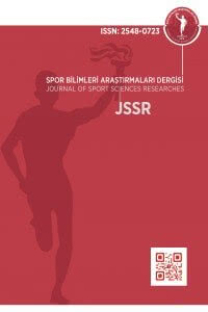The Effect of Combined Exercise (Interval and Polymetric) on Some Physical Fitness Parameters in Middle-Age Men
___
Aghamollaei, T., Tvafian, S., & Hasani, L. (2008). Self-efficacy, perceived benefits and barriers to physical activity instudents of Hormozgan University’s medical science. J Iran epidemiology, 4(3), 9-15. [URL:http://irje.tums.ac.ir/article-1-128-en.html].Bompa, T. O. (1994). Theory and methodology of training: the key to athletic performance. Iowa: Kendall Hunt Publishing Company.
Bompa, T. O., & Haff, G. G. (2009). Periodization: Theory and methodology of training. Champaign: Human Kinetics Publishers.
Buchheit, M., Mendez-Villanueva, A., Quod, M., Quesnel, T., & Ahmaidi, S. (2010). Improving acceleration and repeated sprint ability in well-trained adolescent handball players: speed versus sprint interval training. Int J Sports Physiol Perform, 5(2), 152-164.
Campo, S. S., Vaeyens, R., Philippaerts, R. M., Redondo, J. C., de Benito, A. M., & Cuadrado, G. (2009). Effects of lower-limb plyometric training on body composition, explosive strength, and kicking speed in female soccer players. The Journal of Strength & Conditioning Research, 23(6), 1714-1722.
Chelly, M. S., Ghenem, M. A., Abid, K., Hermassi, S., Tabka, Z., & Shephard, R. J. (2010). Effects of in-season short-term plyometric training program on leg power, jump-and sprint performance of soccer players. The Journal of Strength & Conditioning Research, 24(10), 2670-2676.
Chimera, N. J., Swanik, K. A., Swanik, C. B., & Straub, S. J. (2004). Effects of plyometric training on muscleactivation strategies and performance in female athletes. Journal of Athletic Training, 39(1), 24-31.
Cormie, P., McGuigan, M.R., & Newton, R.U. (2011). Developing maximal neuromuscular power. Sports medicine, 41(1), 17-38.
De Villarreal, E.S.S., Requena, B., & Newton, R.U. (2010). Does plyometric training improve strength performance? A meta-analysis. Journal of Science and Medicine in Sport, 13(5), 513-522.
Diallo, O., Dore, E., Duche, P., & Van Praagh, E. (2001). Effects of plyometric training followed by a reduced training programme on physical performance in prepubescent soccer players. Journal of sports medicine and physical fitness, 41(3), 342-348.
Dupont, G., Akakpo, K., & Berthoin, S. (2004). The effect of in-season, high-intensity interval training in soccer players. The Journal of Strength & Conditioning Research, 18(3), 584-589.
Fabricius, D. L. (2011). Comparision of aquatic-and land-based plyometric training on power, speed and agility in adolescent rugby union players. Master Thesis. Stellenbosch: Stellenbosch University.
Hosiso, M. (2013). Effects of aerobic exercise on improving health related physical fitness components of Dilla University sedentary female community. International Journal of Scientific and Research Publications, 3(12), 1-6.
Hottenrott, K., Ludyga, S., & Schulze, S. (2012). Effects of high intensity training and continuous endurance training on aerobic capacity and body composition in recreationally active runners. Journal of Sports Science and Medicine, 11(3), 483-488.
Luebbers, P. E., Potteiger, J. A., Hulver, M. W., Thyfault, J. P., Carper, M. J., & Lockwood, R. H. (2003). Effects of plyometric training and recovery on vertical jump performance and anaerobic power. The Journal of Strength & Conditioning Research, 17(4), 704-709.
Martel, G. F., Harmer, M. L., Logan, J. M., & Parker, C. B. (2005). Aquatic plyometric training increases vertical jump in female volleyball players. Medicine and science in sports and exercise, 37(10), 1814-1819.
Masamoto, N., Larson, R., Gates, T., & Faigenbaum, A. (2003). Acute effects of plyometric exercise on maximum squat performance in male athletes. The Journal of Strength & Conditioning Research, 17(1), 68-71.
Nikroo, H., & Barancheshme, M. A. (2014). The Comparison of effects of aerobic interval and continuous training program on maximal oxygen consumption, body mass index, and body fat percentage in officer students. Journal Mil Med, 15(4), 245-251.
Polhemus, R., Burkhardt, E., Osina, M., & Patterson, M. (1980). The Effects of plyometric training with ankle and vest weights on conventional weight training programs for men and women. Strength & Conditioning Journal, 2(1), 13-17.
Ross, M. D. (2011). The Influence of an acute bout of resistance exercise on circulating endothelial progenitor cells and endothelial microparticles in trained men. Master Thesis. Waterford Institute of Technology.
Sassi, R., Reilly, T., & Impellizzeri, F. (2005). A comparison of small-side games and interval training in elite professional soccer players. T. Reilly, J. Cabri & D. Araujo (Ed.) Science and football V. Oxon: Routledge, 352-354.
Sharifirad, G. R., Mohebi, S., & Matlabi, M. (2007). The Relationship of physical activity in middle age and cardiovascular problems in old age in retired people in Isfahan. The Horizon of Medical Sciences, 13(2), 57-63.
Short, K. R., Vittone, J. L., Bigelow, M. L., Proctor, D. N., Rizza, R. A., Coenen-Schimke, J. M., & Nair, K. S. (2003). Impact of aerobic exercise training on age-related changes in insulin sensitivity and muscle oxidative capacity. Diabetes, 52(8), 1888-1896.
Singh, A., Sakshi, G., & Singh, S. J. (2014). Effect of plyometric training on sand versus grass on muscle soreness and selected sport-specific performance variables in hockey players. Journal of Human Sport & Exercise, 9(1), 59-67.
Thomas, K., French, D., & Hayes, P. R. (2009). The effect of two plyometric training techniques on muscular power and agility in youth soccer players. The Journal of Strength & Conditioning Research, 23(1), 332- 335.
- ISSN: 2548-0723
- Yayın Aralığı: 3
- Başlangıç: 2016
- Yayıncı: Kadir YILDIZ
Amin AZİMKHANİ, Keyvan HEJAZİ, Reza AMİNZADEH
Gebelik Yogasının Fizyolojik ve Psikolojik Etkileri: Bir Sistematik Derleme
RUKİYE HÖBEK AKARSU, Gülay RATHFİSCH
Türk Spor Medyasında Kadın Gazetecilere Yönelik Cinsiyet Ayrımcılığı
Elit Basketbolcuların Tribün Etkisi Algılarının İncelenmesi
Eğitsel Oyunlar Etkinliğine Katılımın Çocuklardaki Denge, Reaksiyon ve Çeviklik Üzerine Etkisi
Emire ÖZKATAR KAYA, Yaşar KÖROĞLU, NAZMİ SARITAŞ, MUSTAFA KAYA, SERDAR SUCAN
Amin AZİMKHANİ, Keyvan HEJAZİ, Reza AMİNZADEH
Mehmet GÖKTEPE, MEHMET GÖKTEPE, Erdem ÇÖTEN
Gönül TEKKURŞUN DEMİR, Anıl TÜRKELİ
Buz Tırmanışı Yapan Dağcıların Yaşam Kalitesinin İncelenmesi
Türkiye Süper Liginde Üç Büyük Futbol Kulübünün Başkanlarının Söylem Analizi: 2015-2016 Sezonu
